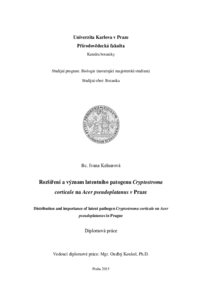Rozšíření a význam invazního patogenu Cryptostroma corticale na Acer pseudoplatanus v Praze
Distribution and importance of invasive pathogen Cryptostroma corticale on Acer pseudoplatanus in Prague
diploma thesis (DEFENDED)

View/
Permanent link
http://hdl.handle.net/20.500.11956/62063Identifiers
Study Information System: 144532
Collections
- Kvalifikační práce [20084]
Author
Advisor
Consultant
Černý, Karel
Referee
Sumíková, Taťána
Faculty / Institute
Faculty of Science
Discipline
Botany
Department
Department of Botany
Date of defense
10. 6. 2015
Publisher
Univerzita Karlova, Přírodovědecká fakultaLanguage
Czech
Grade
Excellent
Sazná nemoc kůry (sooty bark disease) způsobená fytopatogenní houbou Cryptostroma corticale je jednou z aktuálních hrozeb pro populaci javoru klenu v Evropě. Od prvního nálezu v Praze v roce 2005 bylo zaznamenáno několik desítek jedinců uhynulých v důsledku nákazy tímto patogenem, ale lze předpokládat vyšší míru nákazy přetrvávající v latentní nesymptomatické fázi. Hlavním cílem práce bylo kvantifikovat latentní výskyt C. corticale v Praze na základě brzké detekce v pletivech stromů bez vnějších symptomů, identifikovat ekologické nároky tohoto patogenu a stresové faktory podmiňující rozvoj infekce. Dalším cílem bylo na základě získaných dat predikovat rizika pro pražskou populaci javoru klenu a vytipovat další ohrožené lokality v Praze. Sekundárně bylo v práci hodnoceno i spektrum hub kolonizujících xylém javoru klenu. Vzorky pletiv odebrané pomocí Presslerova nebozezu byly podrobeny: a) izolací kultivovatelných hub na sladinový agar a b) detekcí DNA C. corticale na základě nested PCR s druhově specifickými primery. Latentní nákaza byla detekována ve 28 vývrtech. Z 27 pozitivních případů detekce pomocí nested PCR se specifickými primery bylo 10 podpořeno i izolací C. corticale na agar. Pouze v jednom případě nebyla pozitivní izolace C. corticale na agar potvrzena pomocí nested PCR. Přítomnost...
Sooty bark disease (SBD) caused by pathogen Cryptostroma corticale is one of the current risks to the population of sycamores in Europe. A few dozen individuals were fallen death due to sooty bark disease from the first record in Prague in 2005. However a higher rate of infection in a latent non-symptomatic stage can be assumed. The main goal of the thesis was to quantify the extent of infection C. corticale in Prague on the basis of early detection in tissues of symptomless trees and identify its environmental requirements and stress factors conditioning the progression of the disease. Another goal was to predict the risk for Prague's population of sycamore based on obtained data and identify other vulnerable sites in Prague. A secondary aim was to assess the spectrum of fungi inhabiting xylem of sycamore. Tissue samples collected with an increment borer were subjected to: a) isolation of cultivable fungi on malt agar and b) detection of the DNA C. corticale based on nested PCR with species- specific primers. Latent infection was detected in 28 of the cores. Of 27 positive detections with primer specific nested PCR 10 were supported by isolation of C. corticale on agar plates. Only in one case positive isolation of C. corticale on agar plate was not confirmed by nested PCR. Occurrence of C....
